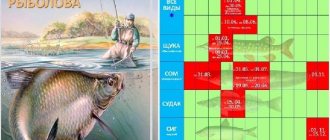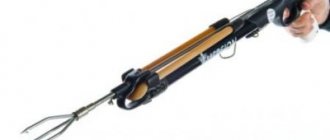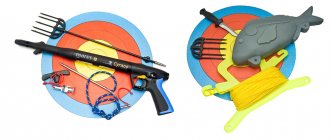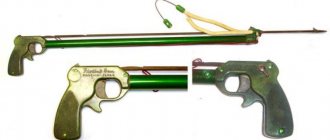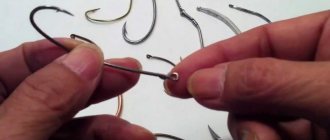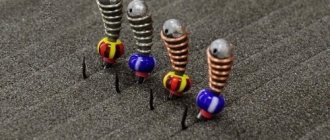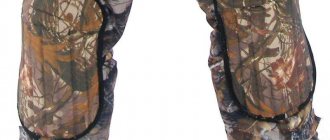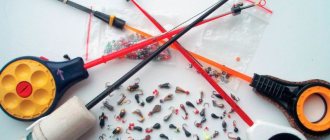In stationary winter fishing, the nod crossbow is used for catching bottom-fed fish. Bream, crucian carp, large roach, when picking up food from the bottom, suck up edible particles like a vacuum cleaner, along with soil and sand. At the same time, these fish automatically get rid of inedible particles, swallowing only food particles. Therefore, when a bream or crucian carp feels the weight of a jig or the bait in its mouth, it immediately tries to get rid of the inedible component. Thanks to its design, the crossbow guard neutralizes the weight of the bait when lifted, which allows the fish to easily swallow the bait. In this article we will look in detail at the features of fishing with such a winter fishing rod. Let's look at how to make the correct crossbow nod for winter fishing with your own hands.
Fishing technique
As already noted, winter crossbow fishing is stationary fishing for bream and crucian carp, as well as large roach from the bottom in winter or summer from a boat vertically. The equipment with the nozzle is lowered into the hole, the guard is installed in the working position. Naturally, the crossbow itself must be clearly adjusted to the weight of this equipment - otherwise it simply will not work. With a careful bite, the nod arrow rises and trembles in a certain middle position. When the nod rises, stops and does not fall, the bait is in the mouth of the fish, you need to hook it. The rubber shock absorber tends to raise the guard to its maximum point. If the fish throws the bait in the process, the arrow will jump to the top position (the opposite if there is no limiter in the design). Tactically, crossbow fishing in winter is no different from standard stand-up ice fishing. If it does not take the riser, it is recommended to sometimes carefully lift the bait from the bottom and tap it on the bottom to play with it.
This is interesting: Wild berries: pictures for children with names
Required tools for assembly
To make the device you will need 8 parts, which you cannot do without. Before assembling the structure, you should go to the store and purchase the following materials and tools:
- round fishing band;
- whip;
- hard and light plate;
- waterproof glue;
- several cambrics;
- a pair of heat shrink tubes;
- metal wire;
- pliers;
- knife;
- scissors;
- a box of matches.
Step-by-step construction of a fishing structure
Experienced fishermen claim that with proper manufacturing, you can get a truly effective crossbow, due to which the catch will increase significantly. The step-by-step action plan is as follows:
- Take a metal wire and make a frame out of it with parameters of 20 cm.
- The wire base is mounted on the whip. You will need heat shrink tubing to secure it. There should be a distance of 1 cm from the arc of the crossbow to the edge of the whip.
- Next comes the preparation of cambric sections for the main fishing line, onto which cyanoacrylate waterproof glue is applied.
- These sections, pre-treated with glue, are fixed to the wire frame and the edge of the whip.
- Next, the elastic is folded in half, and the edges are necessarily tied. The pieces should be pulled onto the frame with some ease, not too loose, but not too tight.
- In this step, a rubber loop is threaded through the silicone tube.
- A rigid plate is attached to one of the edges of the cambric. Fastening is done using glue.
- The manufactured guard is installed in the hole of the silicone tube. It should be between the elastic strands. This will create a device arrow.
- The resulting arrow is attached to a wire frame. This is how a crossbow is made. The product is mounted to the fishing rod, and the main line is inserted through the cambrics, which is equipped with a weight and similar fishing elements.
By twisting the edges of the elastic band, the device is configured. The reel should not have a locking mechanism. The unwinding of the line should not be fast. Otherwise, adjusting the crossbow will become significantly more difficult. The main task in fishing is to deliver bait to the bottom of the reservoir using a homemade structure. The parameters of the bait and its weight depend on the intended fish, the probability of catching which is very high. A do-it-yourself crossbow can also be made according to your design preferences.
Design and adjustment to the weight of the equipment
There is no single design for a crossbow winter fishing rod - there are many design options, but they are all made on the basis of a single principle. The base is a rubber shock absorber, twisted in the opposite direction from the hole (to raise the nod, not lower it). The harness is attached to the horns of the wire frame. An arrow is inserted into the twist in various ways. The simplest thing is into the slot of the cambric placed on the flagellum. The arrow itself is often an ordinary lavsan or metal nod, but hard thin blanks (for example, carbon) can also be used. It's just a lever.
The twist tends to turn around, raising the guard accordingly. This force is limited by the load on the gear. The correct setting is the selection of the twisting speed. The more revolutions, the more the twist raises the needle. The greater the mass of equipment required to balance the system.
Settings
To set up the crossbow fishing winter tackle, remove the shock absorber from one horn and turn it around, putting it in place. We do the same on the other side. To increase elasticity, twist it towards the rod; to decrease it, on the contrary, release it. The frame itself on which the elastic band is attached can be of various shapes, made of plastic or metal. It’s good if the design provides a limiter - then in the maximum upper position the arrow rests against it. If there is no such limiter, then the guard in the upper position will bend in the opposite direction by 180 degrees and lie on the fishing rod, which is inconvenient.
There are many designs of such nods. They differ in the manufacture of elements - the frame itself, the method of attaching the elastic band. In the most sophisticated models, the elastic band is not simply attached to the horns of the frame, but is hinged through special caps that can rotate. Thanks to this, you can adjust the elastic band by simply twisting these caps without removing them from the horns. This setting is subtler - you can tighten the cap to any value, and after removing it the minimum step is one turn.
In the process of adjusting the elastic, we ensure that the equipment in the water barely keeps the nod from lifting. To install it in the working position, when almost all of the equipment is already lowered into the water, we smoothly lower the tackle to the bottom. The nod should remain in a horizontal position (or slightly tilt towards the water). You should not make sudden movements - otherwise the arrow will rise. Excess line is removed (given away) by the reel.
Video of making and setting up a crossbow nod with your own hands:
Pros and cons of the "crossbow"
“Crossbow” is a winning tackle option for catching bream in winter. It is intended for use in severe frost and wind. Many people take it for fishing in the current. All popular solutions are suitable as bait: plant food, maggots and worms, modern designs - jerky. The device lasts for many years - 3-4 seasons exactly. Advantages:
- clear display of even the most careful bite;
- simple, quick adjustment of the mechanism for baits of any variety;
- the fish does not feel the resistance of the nod, the weight of the hook, or the bait.
The disadvantages include the following nuances:
- just smooth, slow play. With sharp, frequent movements, the nod rises;
- The setting gets lost quickly. The bait immerses only smoothly.
Nod "crossbow"
Equipment
There are no special installations for equipping a crossbow with a winter fishing rod. Depending on the conditions of the reservoir, the entire set of winter equipment for fishing rods in still water is used. More often it is one jig or a sinker with a hook and a hook. Any installation is suitable for working the tackle to rise from the bottom. Naturally, a heavy sinker at the end and a retractable leash will not work. When biting, the entire equipment must rise - this is the basic principle of operation of a winter fishing rod with a crossbow nod. The crossbow only works with bottom lifting rigs.
This is interesting: How to determine the age of a moose
A crossbow requires a fishing rod with a reel. This is necessary for an accurate working trigger. Excess fishing line on tackle with reels cannot be removed up to a centimeter.
In fishing stores you can occasionally find ready-made crossbows. However, more often they are imperfect and made without taking into account all the necessary details (for example, without a limiter). Therefore, fishermen make such guards themselves. No special knowledge or skills are required for this - you can assemble the tackle literally on your knees with the simplest tools using available materials. Let's look at how to make a crossbow for a winter fishing rod with a nod.
Winter fishing rod-crossbow - what is it?
A winter crossbow fishing rod is a type of tackle that looks like a slingshot. In fact, it is based on a rubber shock absorber harness, twisted in the opposite direction from the hole in the ice.
A nod with a large bend angle signals a bite. The fishing rod is designed for stationary ice fishing, namely stand-up fishing. Used only in still water or weak currents, mainly for catching bottom fish, such as:
Fishing rod with a nod.
- bream;
- crucian carp;
- roach;
- ide.
DIY crossbow tackle
Let's look at the process of making the popular version of the gatehouse crossbow with our own hands, based on a wire frame. To do this you will need the following tools and materials:
- Elastic band (aircraft model round fishing band or regular one with a square section).
- Silicone casing of the required diameter (so that the flagellum of the elastic band folded in half will fit through)
- Materials for attaching the frame to the rod of the fishing rod - heat-shrink tubes, threads, braid, glue, epoxy, etc.
- Nod for arrow.
- Knife, pliers, awl, lighter.
Frame
The basis of the crossbow is a wire frame. The configuration may be different, but it is still better to adhere to certain dimensions, since they were selected empirically after the practice of many anglers on the reservoir. The frame is bent so that the front part is approximately 5-6 cm wide (the distance between the horns for attaching the elastic band). The side branches are about 7 cm, converge in a triangle at one point for attachment to the whip. In the simplest version, these can be two wires diverging at the required distance. However, it is better to bend the frame with a limiter for the upper position of the nod (in the picture). The horns should diverge slightly to the sides so that the elastic does not slip off.
Shock absorber
The elastic band is folded in half and, with a slight tension, is tied to the horns of the frame. You can tie it with regular knots and trim the ends. We put a cambric with a slot for the arrow on the flagellum and put the entire shock absorber on the horns, inserting them into the end loops of the twist. The flagellum should be slightly stretched and not sag. There is no need to retighten either. The nod is inserted into the slot of the tube so that the form passes between the elastic bands and comes out on the other side by 1-2 cm, while being tightly held in the twist.
Arrow (nod)
Attaching to a fishing rod
All that remains is to attach the arms of the structure to the fishing rod. This can be done in any suitable way. The simplest thing is to insert the ends of the wire into the cambric, in which there will then be a gap for pulling it onto the whip, or wrap it with electrical tape. It’s more reliable to secure everything with heat shrink. The strongest way is to make a tie like on pass rings, wrap it with braid and seal it with moment, superglue or epoxy. Any waterproof cyanoacrylate-based adhesive will do. The do-it-yourself winter crossbow fishing rod is ready - all you have to do is tighten the rubber band to the weight of the equipment and adjust the load capacity.
Alternative options
Shcherbakov's side nod
The same principle of balance is used in Shcherbakov's side nod. This nod is also very sensitive, easier to set up than a crossbow, but more difficult to manufacture.
- A small bearing is placed in tension at the end of the whip. For reliability, the bearing installation location is coated with waterproof glue.
- An iron rod - a rocker arm - is soldered to the top of the bearing perpendicular to the whip.
- On the longer arm of the rocker there is an eyelet for pulling the fishing line.
- A weight is placed on the other shorter arm of the rocker arm.
Balance is achieved by moving the weight along the short arm of the rocker arm or by putting on additional weights.
When grabbing the bait, the fish also does not feel any resistance; the tip of the nod reacts to the slightest bite.
Equilibrium platforms
This method of achieving balance does not require any additional equipment to be installed on the fishing rod.
- Two wooden rectangular narrow platforms are located one above the other.
- On the lower platform there is a wooden triangular post with a semicircular top fixed in the middle.
- In the center of the semicircular top, recesses were drilled with a drill.
- Along the edges of the upper platform in the middle, nails with bitten off heads are symmetrically driven in, bent at some distance at 900 degrees towards each other.
- The curved pieces of the top platform nails are inserted into the triangular post holes on the bottom platform.
- The platforms are balanced by moving a regular winter fishing rod forward or backward.
Due to the semicircular apex of the triangle, the platforms will still be in a state of equilibrium with a small impact.
The fishing rod is not attached to the platform and rests freely on the horns of the upper platform. When biting, the platform sways or is thrown out of balance. A swaying or falling down of the front or back of the upper platform signals a bite.
The horns are inserted into the holes of the upper platform; if necessary, they can be rearranged or completely removed, since the balalaika can simply be placed on the upper platform.
The design is unpretentious, but quite sensitive. It is better to use it in a tent or in calm weather.
Execution options
There is no single drawing of a crossbow for do-it-yourself winter fishing - there are so many anglers, so many opinions. And everyone considers their design to be the best. The main thing is that the shock absorber works, the rest is a matter of personal preference. For example, you can tinker with the way you attach the elastic to the frame. Don't just tie it, but place it on hinged caps so that you can adjust the tension without removing the elastic.
Fishing with a crossbow - useful DIY equipment
Bowfishing is a very unusual and exciting way to catch fish. Shooting a fish with a crossbow is not ordinary fishing, when you sit and look at the float, it is a real adventure with running, freezing and aimed shots. In addition to the mandatory ones for fishing - a compound bow or crossbow, special arrows made of aluminum or carbon fiber and a bowfishing reel with thick fishing line - you may need the following equipment, which will significantly help in the process of hunting for river inhabitants.
With the help of special devices, you can turn an ordinary crossbow into do-it-yourself crossbow for fishing how to load a crossbow for underwater hunting easily and quickly.
How to make a crossbow for fishing (bowfishing): useful accessories for a crossbow for bowfishing
- Shelf for arrows. This device can facilitate the process of installing and holding an arrow in a taut bowstring. Thanks to it, the arrow will take the desired position and you won’t have to worry about it. For bowfishing, they produce special racks for arrows, since these arrows differ from the usual hunting arrows.
- Club An archer-fisherman hunts for large fish, so it doesn’t hurt to have a club with you to stun a large specimen. Otherwise, the fish will jump along the shore or boat and, jumping into the river, swim away. There are clubs with a soft surface that stuns fish.
- Container for storing catch A common practice for fishermen. It is more convenient to store fish in a special container and it is better if it is a container with a cooler. This way the fish will last longer.
- Yellow Polarized Sunglasses Sunglasses with polarized lenses reduce glare from the water, making visibility better and at the same time protecting the hunter's eyes.
Harpoon for a crossbow and how to properly tie a line to the harpoon of an underwater crossbow. The Arabalt Harpoon is an arrow for an underwater crossbow. It will help you hold and retrieve the caught fish. The fish will not fall off such an arrow and will not swim away. To make hunting fish with a crossbow more effective, it is important to know how to properly tie a harpoon to a crossbow and the line itself to the harpoon. it's actually not difficult if you watch the video.
Crossbow nod design
The structure of the fishing rod is absolutely simple, its shape resembles a weapon that was used in ancient times, however, that’s why it got its name.
The main component is a frame made of stainless metal. The material used in manufacturing is important, since if it comes into contact with water, parts made of other materials may rust and performance will be impaired.
The rod should be 0.09 millimeters from one side to the other, which runs through the middle. The sides located on the left and right are 5 cm, but the required width is less than 6 centimeters.
The shoulders, which are located on both sides, have curves on which you need to pull a circle of rubber.
Rubber must meet the requirements, which means:
- Tolstoy;
- Elastic.
The cambric is the hole through which the fishing line should be passed. A fishing rod that should be used in conjunction with a crossbow must have a smooth fastening and a reel.
Fishing using this device requires care and patience. Recommendations for use:
- When throwing, the nod should be located above the hole;
- The frame is installed over a length that is selected individually. Focus on the middle of the slingshot;
- The nod is placed in a horizontal position;
- Weights are attached to the gear used using fishing line.
Advantages and disadvantages
Tackle in the form of a crossbow facilitates fishing in severe frosts, as well as at great depths. The device lasts for 3 to 7 winter periods if it is properly cared for.
It is allowed to attach bait of the following kind to the fishing rod:
- Worms;
- Bread;
- Bloodworm;
- Cookies and other types of bait.
The advantages of using a crossbow include:
- Use in any period of winter and even in windy conditions;
- A lucky bite that even beginners can master;
- Works with any bait;
- It's easy to pull out fish without feeling the weight.
The disadvantages are:
- Smooth movements that should be used when fishing;
- Mandatory crossbow setup.
DIY bowfishing reel for crossbow
A crossbow fishing reel is an essential accessory for hunting fish with a crossbow . It’s easier than ever to buy a special reel, but it’s much more interesting to make it yourself. For this you can use any plastic drum and even a plastic bottle. It is necessary to drill a hole in it for the fishing line and secure it with a reliable knot. in more detail, learn how to make a reel for a fishing crossbow from video clips.
Of course, you can completely do without some accessories, some of them may never be useful, but there is no such thing as too much forethought. Make your fish hunting not only fun, but also hassle-free.
A quality fishing rod for winter fishing - what is it?
A winter fishing rod, unlike a summer fishing rod, is short in length, compact and simple in design. Convenient models are equipped with a nod (guard). With such an element, you can count on the necessary play with bait and prompt signaling of a bite. It is attached to the whip using a small clamp, electrical tape or wire.
Homemade fishing rods with similar designs are not inferior to branded ones. The main thing is to do everything during manufacturing as the professionals advise.
The “crossbow” nod for catching bream is the same small-sized winter fishing rod that has a rubber shock absorber. The idea of using such a mechanism is not new. The first such models appeared in the 70s. Models with a guard and a rubber shock absorber do not give everything away due to the time spent on manufacturing, however, those who were not too lazy to design the device note the high efficiency of the product.
The crossbow is based on a stainless steel frame with a diameter of 0.9 mm. The average length of the shoulders is 5 cm, the total width is 7 cm. A rubber ring serves as a shock absorber, which is put on, stretched tightly, over the horns. As for the cambrics, they are located on the six and gatehouse. The optimal fishing rod for a crossbow is a model in which the reel does not lock quickly.
What is a crossbow like in action? Using it, you can fish with one tackle and any bait in different ways: at maximum depth with lifting, playing, using the method of slowly lowering the bait. When casting a fishing rod, it is not recommended to lower the tip of the nod as much as possible above the water. During the setup process, it would be good to install the element in a horizontal position.
This way he will better detect the bite. As for the gatehouse, it is already regulated on site. Adjustment for baits of a certain weight is carried out by increasing/decreasing the number of revolutions. An additional sinker can be placed both on the fishing line and outside it. Due to the well-designed design, when pulling out a fish, it does not feel the weight of the jig and sinker during the lifting process.
